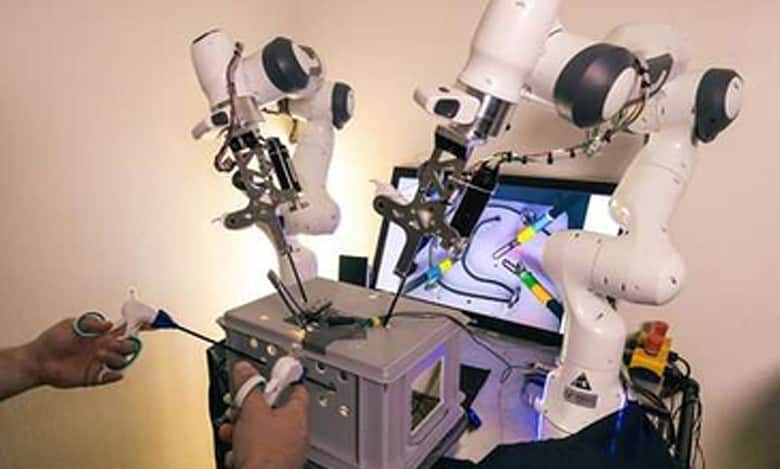1st 4-arm laparoscopic surgical device to improve performance of surgeon
Roboticists at Ecole Polytechnique Federale de Lausanne (EPFL) in Switzerland have developed an advanced system that represents a groundbreaking leap in the field of laparoscopic surgery. The system combines multi-limb manipulation with sophisticated shared-control augmentation.
In this innovative setup, each hand of the surgeon operates a manipulative instrument, while one foot controls an endoscope/camera, and the other foot operates an actuated gripper. The key aspect of this system lies in the shared control mechanism, enabling seamless collaboration between the surgeon and robotic assistants within a concurrent workspace. This setup ensures that the precision and safety requirements of laparoscopic surgery are consistently met.
Mohamed Bouri, the head of the Rehabilitation and Assistive Robotics (REHAssist) group at EPFL, explained one essential feature of the system. Actuators in the foot pedals provide haptic feedback to the user, guiding the foot towards the target as if following an invisible field-of-forces. Moreover, these actuators limit force and movement to prevent any accidental movements that could pose a risk to the patient.
By allowing a single surgeon to perform 4-handed laparoscopic procedures, the system introduces new possibilities in surgical procedures. Tasks that typically require the involvement of two or even three people can now be efficiently carried out by a single individual using this state-of-the-art robotic assistance system.

The foot pedals of this innovative system incorporate actuators that provide tactile feedback to the user, guiding the foot precisely toward the target and restricting force and movement to ensure patient safety by preventing any inadvertent foot movements. This cutting-edge concept of shared control revolutionizes laparoscopic surgery, enabling a single surgeon to perform four-handed operations that would typically require a team of two to three individuals. The system's shared-control capabilities even allow the robotic components to anticipate the surgeon's intended movements, preemptively directing the instrument control. For example, during knot tying, the endoscope aligns itself correctly, and the gripper adjusts its position to avoid obstructions.
To evaluate the system's effectiveness and user-friendliness, the research team conducted a comprehensive user study involving practicing surgeons. The results demonstrated that the system has the potential to reduce surgeons' workload while improving precision and safety. The integrated shared-control strategies were shown to lessen task load, enhance performance, promote fluency, and improve coordination during laparoscopic procedures. Despite ongoing testing and refinement, the system has already shown promise in facilitating four-arm surgical tasks without the need for extensive training. It has been successfully used for specialist training, and clinical trials are currently underway.
Professor Aude Billard, head of the Learning Algorithms and Systems Laboratory (LASA), acknowledged that controlling four arms simultaneously, especially with one's feet, is far from routine and can be tiring. To address this, the robots actively assist the surgeon by coordinating their movements with the surgeon's actions, using active prediction of the surgeon's intent and adaptive visual tracking of laparoscopic instruments with the camera. The system also provides assistance for more precise tissue grasping, further enhancing its capabilities in the surgical setting.
Top
In this innovative setup, each hand of the surgeon operates a manipulative instrument, while one foot controls an endoscope/camera, and the other foot operates an actuated gripper. The key aspect of this system lies in the shared control mechanism, enabling seamless collaboration between the surgeon and robotic assistants within a concurrent workspace. This setup ensures that the precision and safety requirements of laparoscopic surgery are consistently met.
Mohamed Bouri, the head of the Rehabilitation and Assistive Robotics (REHAssist) group at EPFL, explained one essential feature of the system. Actuators in the foot pedals provide haptic feedback to the user, guiding the foot towards the target as if following an invisible field-of-forces. Moreover, these actuators limit force and movement to prevent any accidental movements that could pose a risk to the patient.
By allowing a single surgeon to perform 4-handed laparoscopic procedures, the system introduces new possibilities in surgical procedures. Tasks that typically require the involvement of two or even three people can now be efficiently carried out by a single individual using this state-of-the-art robotic assistance system.

The foot pedals of this innovative system incorporate actuators that provide tactile feedback to the user, guiding the foot precisely toward the target and restricting force and movement to ensure patient safety by preventing any inadvertent foot movements. This cutting-edge concept of shared control revolutionizes laparoscopic surgery, enabling a single surgeon to perform four-handed operations that would typically require a team of two to three individuals. The system's shared-control capabilities even allow the robotic components to anticipate the surgeon's intended movements, preemptively directing the instrument control. For example, during knot tying, the endoscope aligns itself correctly, and the gripper adjusts its position to avoid obstructions.
To evaluate the system's effectiveness and user-friendliness, the research team conducted a comprehensive user study involving practicing surgeons. The results demonstrated that the system has the potential to reduce surgeons' workload while improving precision and safety. The integrated shared-control strategies were shown to lessen task load, enhance performance, promote fluency, and improve coordination during laparoscopic procedures. Despite ongoing testing and refinement, the system has already shown promise in facilitating four-arm surgical tasks without the need for extensive training. It has been successfully used for specialist training, and clinical trials are currently underway.
Professor Aude Billard, head of the Learning Algorithms and Systems Laboratory (LASA), acknowledged that controlling four arms simultaneously, especially with one's feet, is far from routine and can be tiring. To address this, the robots actively assist the surgeon by coordinating their movements with the surgeon's actions, using active prediction of the surgeon's intent and adaptive visual tracking of laparoscopic instruments with the camera. The system also provides assistance for more precise tissue grasping, further enhancing its capabilities in the surgical setting.

.jpg)
